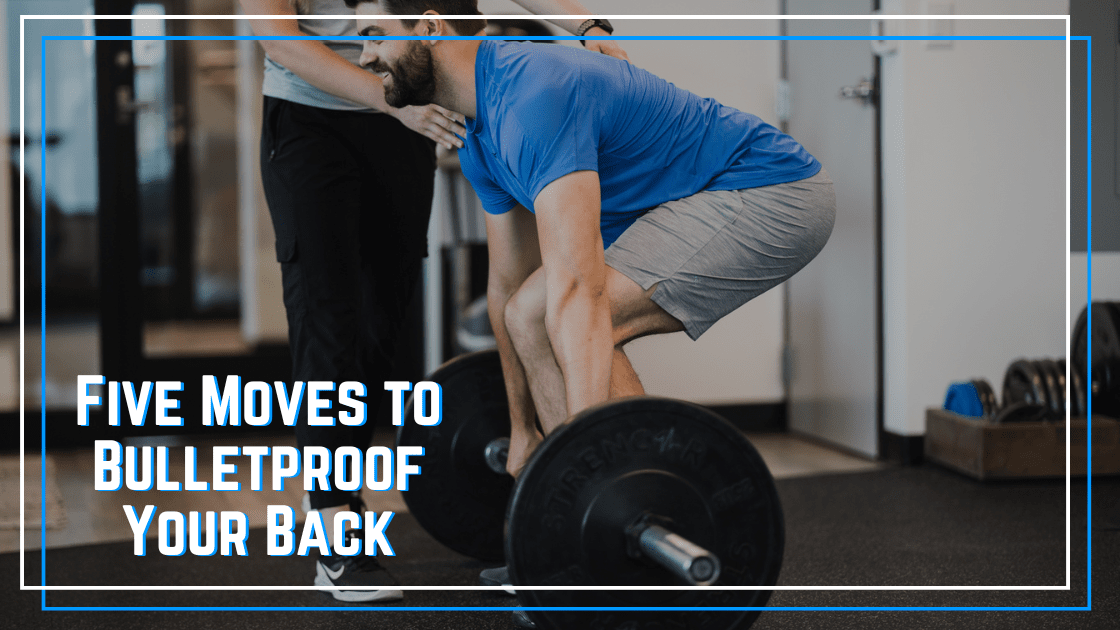In this video, we’re talking about the best exercises for a bulletproof back, that is exercises that build a stronger spine. For more, please be sure to check out our Bulletproof Back Builder accessory program!
The low back is typically overlooked when we’re talking about sports performance and helping to improve moves like your squat and your deadlift. We so often focus on just building leg strength, building glute strength, and we ignore the back, which is a crucial component to putting more load on your barbell-based lifts. Or if we’re talking about a rehab perspective, far too often in rehab we focus on hip mobility, glute strength, core strength in people that have back pain, but instead, I think a lot of times we need to have more emphasis on actually strengthening the back itself. We’re going to go through five exercises that I use most frequently in my clinical practice to help people bulletproof their back, from both a performance standpoint and as part of rehab plans.
Bulletproof Back Exericses
Jefferson Curls
The first exercise that we’re going to do for a bulletproof back is actually going to be a Jefferson curl. With a Jefferson curl, we’re working on doing two things. Number one, improving back mobility and our awareness of moving our back segment by segment, and number two, we’re putting a really light load in terms of sub maximal loading of the spine when it is not in neutral, because at times we are going to get out of neutral, as much as we maybe strive to try to maintain a more neutral spine position in our squats and ours deadlifts, we will lose positioning every now and then and we want to be prepared for that.
With the Jefferson curl, we’re typically going to go with a fairly light weight. We’re going to think of, segment by segment, rounding our back, going nice and slow. I’m imagining that my butt is on a wall and my back is on the wall and I’m just peeling one little piece of it off the wall at a time and going down as far as I can, I’ll end up feeling a good stretch in my low back and in my hamstrings, and then we reverse it back up. My upper back’s going to stay rounded and I’m thinking of just putting a little bit of my low back on the wall a little bit more, a little bit more, little bit more, and rounding all the way back up. That is the Jefferson curl. Again, we typically keep that one a little bit lighter than some of these other movements that we’re going to transition to next.
GHD Hip Extension Variations
The second set of exercises that I really like to do are going to be different exercises on the glute ham developer. The GHD is a fantastic machine for building overall posterior chain strength. There are a couple of exercises that I really specifically like for individuals needing low back strength or rehabing from low back pain. Number one is a double leg Sorenson hold. We’re on a GHD, we’re holding our trunk parallel to the ground and we’re simply holding that. That’s a good initiation to these exercises and will actually be fairly challenging, depending on how far out you position your body.
Number two, from there, we can actually do a glute ham developer row. We’re holding that Sorenson plank, but we’re adding a little bit of row to the equation to further challenge our ability to lock in that back position. Finally, we could do some GHD hip extensions, where we hold onto a barbell or we hold onto a band or dumbbells, some sort of weight as we extend and flex our hips up and down. That is going to absolutely crush the lower back.
Reverse Hypers
The third exercise that I really like, in terms of building low back strength, is going to be reverse hypers. By far the best way to do this is going to be on a dedicated reverse hyper machine, such as those put out by Westside Barbell and licensed across multiple different companies, but I know that a lot of gyms don’t have that available so there are a number of different ways that you can do that. Here, you can see me doing that on an incline bench. This is on part of my Squatmax-MD machine. You can see that that pad is set to an incline. You could do this on an actual incline bench yourself. You just want to see that in all of these reverse hyper variations that the low back actually rounds a little bit when you’re in that bottom position and it extends as you come up, so we’re actually strengthening through some range of motion.
If you don’t have that, you can do it off a glute ham developer as well, or you could do it off the end of a bench, not quite as effective, but it’s still a great way to put some accessory strength work on the lower back. You have a couple different options if you don’t actually have a glute ham developer.
Deadlifts for Low Back Pain
Next, we’re going to get to what are my two favorite exercises for bulletproofing the back, especially from people rehabbing from chronic low back pain. Number one is going to be the deadlift. I know what you’re thinking, you’re thinking the deadlift is rough on the back, that it’s one of those things that creates back pain.
Well, actually the research says quite the opposite. There have been a number of different studies that looked at deadlifts for people with back pain and they consistently find reductions in pain, reductions in disability, improvement in strength, improvement in muscle size, improvement in endurance, as well as maybe what’s most important, and that is reduced kinesiophobia. Kinesiophobia means reduced fear of your low back, which we all have that friend, or maybe it’s you watching this right now, that has injured your back before, maybe even a couple of times, and now are scared of your back. Think you have a bad back? Deadlifts are a great way to start building your confidence as well as your actual true physical strength.
A number of different ways we can do that. I’m typically going to program this in terms of the barbell deadlift, where we’re just working on maintaining a neutral spine position, driving through the leg, opening the hips up at the top, keeping that bar nice and close to the body, I’m using my lats to do that. If you want to know more about utilizing deadlifts, there are a number of different articles on thebarbellphysio.com, as well as videos on my YouTube channel that you can check out.
Deadlift Isometric Pulls
Now, for those of you that are already doing deadlifts and maybe experience some pain with deadlifts or back soreness after deadlifts, or you’re consistently missing deadlifts at specific portions in the range of motion where you feel your back cave and you get out of position, then this is going to be my exercise for you. This is going to be some isometric pulls of your deadlift. I’ve got the J-cups on my squat wrap flipped upside down, or you could use safety squat bars and just go to the pins, but what I’m going to do is lift that bar up until it’s on the bottom of those J-cups and I’m going to get positioned exactly how I would be at this spot of the lift if I was actually deadlift.
Now, I’m going to aggressively pull into those J-cups. Obviously, I’m not going to move my squat rack, because it’s pretty heavy and held down to the ground, but I’m going to exert a lot of force trying to keep my back neutral, pulling as hard as I can up into those pins. Isometric pulls are a phenomenal way to work on building strength in those specific ranges of motion that you need to have a little bit more strength in.
There are my five favorite exercises for bulletproofing your back. I hope those give you some great ideas for your training and for your rehab. If you want to see how all of these can be put together into a program, check out our Bulletproof Back Builder program, which I’ll link to in the description below, which is meant as an accessory program for CrossFitters or weightlifters to build more back strength, if that’s what’s holding back your barbell-based lifts. This is programmed as four days a week, little mini WODs lasting between 10 and 15 minutes that will just add a little bit of targeted volume to bring up the weak point of your low back, if that’s what you’re dealing with.






